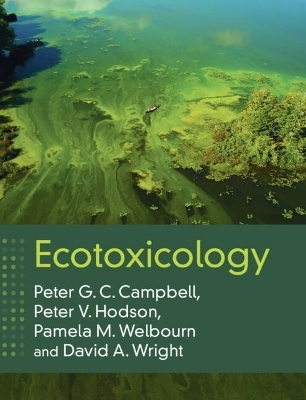
Ecotoxicology
Cambridge University Press (Verlag)
978-1-108-83469-8 (ISBN)
Ecotoxicology offers a comprehensive overview of the science underpinning the recognition and management of environmental contamination. It describes the toxicology of environmental contaminants, the methods used for assessing their toxicity and ecological impacts, and approaches employed to mitigate pollution and ecological health risks globally. Chapters cover the latest advances in research, including genomics, natural toxins, endocrine disruption and the toxicology of radioactive substances. The second half of the book focuses on applications, such as cradle-to-grave effects of selected industries, legal and economic approaches to environmental regulation, ecological risk assessment, and contaminated site remediation. With short capsules written by invited experts, numerous case studies from around the world and further reading lists, this textbook is designed for advanced undergraduate and graduate one-semester courses. It is also a valuable reference for graduate students and professionals. Online resources for instructors and students are also available.
Peter G. C. Campbell is Emeritus Professor at the INRS Eau Terre Environnement Research Centre in Québec City, Canada, which he joined in 1968 after completing his PhD. Over the course of his career he has researched elements of analytical chemistry, geochemistry and ecotoxicology, with an emphasis on metal speciation and bioavailability. He co-directed the Metals in the Environment Research Network from 1998–2009 and held a Canada Research Chair in Metal Ecotoxicology from 2002 until his retirement in 2015. He was elected to the Academy of Sciences of the Royal Society of Canada in 2002 and received the SETAC Founders' Award in 2019. Peter V. Hodson is Professor Emeritus at Queen's University in Kingston, Ontario, Canada. His recent research includes the toxicity of crude oil and oil dispersants to fish embryos and the role of chemicals in the decline of the American eel in Lake Ontario. He has authored numerous peer-reviewed papers, books and technical reports related to the toxicity of chemicals to fish and contamination of the Great Lakes and rivers of Ontario, Quebec, and Alberta. He was President of the Society of Environmental Toxicology and Chemistry (SETAC) (1994–1995) and a member of its Board of Directors and the Board of the SETAC World Council (from 2004 to 2007), serving as the Chair of the World Council Science Committee. He was Program Chair of SETAC's 10th Annual Meeting in Toronto in 1989. Pamela M. Welbourn is currently an Adjunct Professor in the School of Environmental Studies at Queen's University, Canada. She was on the faculty at the University of Toronto from 1970 to 1990, where she was Director of the Department of the Institute for Environmental Studies from 1984 to 1989. Welbourn has published numerous peer-reviewed papers and technical reports, and has co-authored the textbook Environmental Toxicology (Cambridge, 2002). She has consulted for the private and public sector and also for non-governmental organisations. She holds two teaching awards and currently gives guest lectures and public lectures on ecotoxicology. David A. Wright is Emeritus Professor of Environmental Toxicology at the University of Maryland, Center for Environmental Science, USA. While advisor to fifteen MS and PhD students, he has conducted numerous studies on the effect of inorganic and organic contaminants on aquatic organisms. He has published numerous articles, books and technical reports on a variety of toxicological and maritime issues such as invasive species, and has co-authored the textbook Environmental Toxicology (Cambridge, 2002). He is a Fellow of the Institute for Engineering Science & Technology (IMarEST) and was Chief Scientist at the 2010 Gulf of Mexico Deepwater Horizon spill.
Preamble; Preface; Part I. Approaches and Methods: 1. The history and emergence of ecotoxicology as a science Pamela Welbourn and Peter V. Hodson; 2. Measuring toxicity Peter V. Hodson and David A. Wright; 3. Contaminant uptake and bioaccumulation: mechanisms, kinetics and modelling Peter G. C. Campbell, Peter V. Hodson, Pamela M. Welbourn, David A. Wright; 4. Methods in ecotoxicology Peter. V. Hodson and David W. Wright; 5 Ecotoxicogenomics Valérie S. Langlois and Christopher J. Martyniuk; Part II. Toxicology of Individual Substances: 6. Metals and metalloids Peter G. C. Campbell, Pamela M. Welbourn and Christopher D. Metcalfe; 7. Organic compounds Christopher D. Metcalfe, David A. Wright, Peter V. Hodson; 8. Endocrine disrupting chemicals Christopher D. Metcalfe, Christopher J. Martyniuk, Valérie S. Langlois, and David A. Wright; 9. Natural toxins David A. Wright and Pamela M. Welbourn; 10. Ionising radiation Louise Winn; Part III. Complex Issues: 11. Complex issues, multiple stressors and lessons learned Pamela M. Welbourn, Peter G. C. Campbell, Peter V. Hodson and Christopher D. Metcalfe) 12. Regulatory toxicology and ecological risk assessment Peter V. Hodson, Pamela Welbourn and Peter G. C. Campbell; 13. Recovery of contaminated sites Pamela M. Welbourn and Peter V. Hodson; 14. Emerging concerns and future visions David A. Wright and Peter G. C. Campbell; Index.
| Erscheinungsdatum | 19.05.2022 |
|---|---|
| Zusatzinfo | Worked examples or Exercises |
| Verlagsort | Cambridge |
| Sprache | englisch |
| Maße | 221 x 287 mm |
| Gewicht | 1790 g |
| Themenwelt | Naturwissenschaften ► Biologie ► Biochemie |
| Naturwissenschaften ► Biologie ► Ökologie / Naturschutz | |
| Naturwissenschaften ► Chemie ► Organische Chemie | |
| Naturwissenschaften ► Geowissenschaften ► Geologie | |
| ISBN-10 | 1-108-83469-8 / 1108834698 |
| ISBN-13 | 978-1-108-83469-8 / 9781108834698 |
| Zustand | Neuware |
| Informationen gemäß Produktsicherheitsverordnung (GPSR) | |
| Haben Sie eine Frage zum Produkt? |
aus dem Bereich


